London Underground infrastructure
The railway infrastructure of the London Underground includes 11 lines, with 270 stations. There are two types of line on the London Underground: services that run on the sub-surface network that is just below the surface and use larger trains, and the deep-level tube lines, that are for the most part self-contained and use smaller trains. Most of the lines emerge on to the surface outside the Central London area. The oldest trains currently running on the Underground were introduced in 1972. The Underground is electrified using a four-rail system, the DC traction supply being independent of the running rails. Planned improvements include new stations, line extensions and more lines with automatic train operation (ATO).
| Part of a series of articles on the |
| London Underground |
|---|
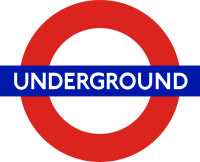 |
|
|
Railway
The total length of railway on the London Underground is 400 kilometres (250 mi) and made up of the sub-surface network and the deep-tube lines.[1] In 1971/72 it was re-measured in kilometres using Ongar as the zero point.[2][3]
Sub-surface network and deep-level tube lines
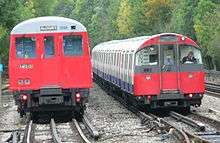
The Circle, District, Hammersmith & City, and Metropolitan lines are services that run on the sub-surface network that has railway tunnels just below the surface and built mostly using the "cut-and-cover" method. The tunnels and trains are of a similar size to those on British main lines. The Hammersmith & City and Circle lines share all their stations and most of the track with other lines. The Bakerloo, Central, Jubilee, Northern, Piccadilly, Victoria and Waterloo & City lines are deep-level tubes, with smaller trains that run in two circular tunnels with a diameter of about 11 feet 8 inches (3.56 m), lined with cast-iron or precast concrete rings, which were bored using a tunnelling shield. These were called the tube lines, although since the 1950s the term "tube" has come to be used to refer to the whole London Underground system.[4] Many of the central London deep-tube line stations, such as those on the Central and Piccadilly lines, are higher than the running lines to assist deceleration when arriving and acceleration when departing.[5] The deep-tube lines generally have the exclusive use of a pair of tracks, except for the Piccadilly line, which shares track with the District line between Acton Town and North Ealing and with the Metropolitan line between Rayners Lane and Uxbridge, and the Bakerloo line, which shares track with London Overground services north of Queen's Park.[6]
There are 20 miles (32 km) of cut-and-cover tunnel and 93 miles (150 km) of tube tunnel, the other 55 per cent of the system running above ground.[1] Trains generally run on the left-hand track, although in some places, for example the Central line east of St Paul's station, tunnels are above each other.[6] The Victoria line has right-hand running between Warren Street and King's Cross St. Pancras, allowing cross-platform interchange with the Northern line (Bank branch) between northbound and southbound trains at Euston.[6][7]
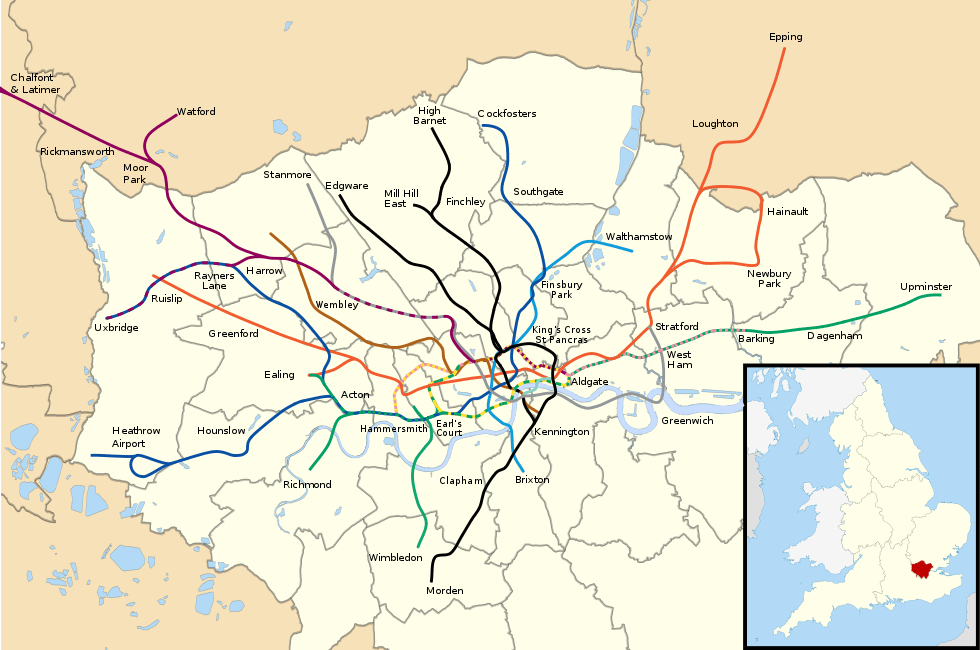
Six of the 32 London boroughs are not served by the Underground. All of these are south of the River Thames: Bexley, Bromley, Croydon, Kingston, Lewisham and Sutton. The borough of Lewisham used to be served by the Underground on the East London line – now part of London Overground – at New Cross and New Cross Gate. Of the boroughs through which the Underground lines pass, Hackney is served solely by Manor House station on the Piccadilly line in the very north-western edge of the borough. For the most part however, some of the tube lines like the Central line skirt around the perimeter of Hackney rather than going straight through it. The Royal Borough of Greenwich had no Underground station until North Greenwich station opened on the Jubilee line extension in 1999.
Electrification
.jpg)
The lines are electrified with a four-rail DC system. The configuration and potential of the conductor rails varies across the network. As of 2020, there are three different conductor rail configurations:
- The original configuration is nominally 630 V with a −210 V centre conductor rail and a +420 V outside conductor rail. This is the default configuration wherever deep-level tube trains operate.[8]
- Beginning in 2016, sections of the sub-surface network were reconfigured to a 750 V configuration (−250 V and +500 V rails). As of 2019, the entire sub-surface network uses this configuration except for Uxbridge to Finchley Road (via Harrow) as 1973 Stock and 1996 Stock (of the Piccadilly and Jubilee lines respectively) share the railway.[9]
- In areas where Underground and third rail rolling stock share tracks, the centre conductor rail is electrically connected to the running rails. This still results in a 750 V voltage, but in a 0 V/+750 V configuration.[8] Lines configured in this manner include:
- Between Gunnersbury and Richmond on the District line, shared with London Overground
- Between East Putney and Wimbledon on a section of the District line that was transferred from British Rail
- Between Queen's Park and Harrow & Wealdstone on the Watford DC line, served by Bakerloo line and London Overground trains
The four rail system was first used in the early 20th century. The isolated traction current return allowed a train's position to be detected using DC track circuits, and reduced any earth leakage currents that could affect service pipes, telephone cables, or cast iron tunnel liners.[10]
The traction current has no direct earth point, but there are two resistors connected in series across the traction supply. The positive resistor is twice as great as the negative resistor, since the positive rail carries twice the voltage of the negative rail. The junction point of the resistors is earthed, establishing the reference point between the positive and negative rails by voltage division. The resistors are great enough to prevent large currents flowing through the earthed infrastructure.
Ventilation and cooling
The Metropolitan Railway's first line was built in the belief that it would be operated by smokeless locomotives and with little thought given to ventilation.[11] Initially the smoke-filled stations and carriages did not deter passengers,[12] the ventilation being later improved by making an opening in the tunnel between King's Cross and Gower Street and removing glazing in the station roofs,[13] and the later extensions and the District Railway were built with stations in the open.[14] With the problem on the original line continuing after the 1880s, conflict arose between the Met, who wished to make more openings in the tunnels, and the local authorities, who argued that these would frighten horses and reduce property values.[15] This led to an 1897 Board of Trade report that reported a pharmacist was treating people in distress after having travelled on the railway with his 'Metropolitan Mixture'. The report recommended more openings be authorised but the underground sections of the Metropolitan and District railways were electrified before these were built.[15]
Forced ventilation was not considered when the deep-tube Central London Railway opened in 1900, engineers considering that the movement of the electric trains would give sufficient air circulation. However, soon after opening there were complaints about a smell that the company couldn't explain, and by 1911 they had installed a system of fans injecting filtered air and ozone.[16] Exhaust fans had been fitted at most stations when the Underground Electric Railways Company (UERL) opened its three tube lines in 1906–7,[10] a maximum temperature of 16 °C (60 °F) in hot weather being advertised on the Bakerloo line.[17] However, over time heat from the trains has warmed up the tube tunnels, and in 1938 approval was given to a £500,000 programme to improve the ventilation and an experimental refrigeration plant was installed in a lift shaft at Tottenham Court Road.[18] More recently, temperatures of 47 °C (117 °F) were reported in the 2006 European heat wave.[19] It was pointed out in 2002 that, if animals were being transported, temperatures on the Tube would break European Commission animal welfare laws.[20] A 2003 study reported that air quality seventy-three times worse than at street level, with twenty minutes on the Northern line having "the same effect as smoking a cigarette".[21]
The main purpose of the London Underground's ventilation fans is to extract hot air from the tunnels[18] and the recent system on the Jubilee line extension was designed to allow cooling of the tubes at night. Fans over the network are being refurbished, although complaints of noise from local residents preclude their use at full power at night.[22] Following a successful demonstration of a heat pump in 2001, funds were given to the School of Engineering at London's London South Bank University to develop a prototype; work began in April 2002. A prize of £100,000 was offered by the Mayor of London during the hot summer of 2003 for a solution to the problem, but the competition ended in 2005 without a winner.[23] A year-long trial of a groundwater cooling system began in June 2006 at Victoria station.[24] The University's system comprised three fan coil units that use water that has seeped into the tunnels and is pumped from the tunnels to absorb the heat after which it is discharged in the sewer system. The scheme was one of the winners in the Carbon Trust's 2007 Innovation Awards.[25][26] In 2012 air cooling units were installed on platforms at Green Park station using cool deep ground water and at Oxford Circus using chiller units at the top of an adjacent building.[27] New air-conditioned trains are being introduced on the sub-surface lines, but space is limited on tube trains for air-conditioning units and these would heat the tunnels even more. The Deep Tube Programme, investigating replacing the trains for the Bakerloo and Piccadilly lines, is looking for trains with better energy conservation and regenerative braking.[28][29]
Stations
The Underground serves 270 stations.[30] Fourteen Underground stations are outside Greater London, of which five (Amersham, Chalfont & Latimer, Chesham, and Chorleywood on the Metropolitan line and Epping on the Central line) are beyond the M25 London orbital motorway.
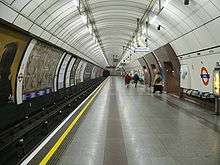
The longest distance between two stations is 3.9 miles (6.3 km) between Chalfont & Latimer and Chesham on the Metropolitan line.[1] The shortest distance between adjacent stations is the 330 yards (300 m) between Leicester Square and Covent Garden on the Piccadilly line.[1] The station furthest south is Morden on the Northern line, 9.9 miles (16 km) from Moorgate. The station furthest east is Upminster on the District line, 16 miles (25 km) from Tower Hill.[1] Chesham on the Metropolitan line is both the northernmost and westernmost station on the network, 29 miles (47 km) from Aldgate.[1] Hampstead is the deepest station below the surface, at 58.5 metres (192 ft), as its surface building is near the top of a hill, and the Jubilee line platforms at Westminster are the deepest platforms below sea level at 32 metres (105 ft). The highest station is Amersham on the Metropolitan line, at 147 metres (482 ft) above sea level and the highest point above ground is the Dollis Brook Viaduct over Dollis Road between Finchley Central and Mill Hill East on the Northern line, 18 metres (59 ft) above the ground.[1]
Lifts and escalators
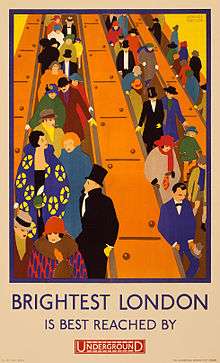
When the City & South London Railway opened in 1890[31] access to the platforms was by two hydraulic lifts, each capable of carrying 50 passengers.[32] The later extensions had electric lifts and five were provided at Bank.[33] Access to the Waterloo & City Railway in 1898 was by slopes and steps,[34] and the Great Northern & City Railway (GN&CR) used both hydraulic and electric lifts. The Central London Railway provided electric lifts when it opened in 1900, and the opening of Bond Street station was delayed as the lifts were not ready.[35] The UERL controversially imported 140 electric lifts from Otis Elevator Company in the U.S. for its three lines. Each carrying about 70 passengers, they were provided at every station except Gillespie Road (now Arsenal) and Embankment, where access was provided via the District's station.[36] Hydraulic lifts were provided at Finsbury Park, powered from the GN&CR pumping station,[37] and at Holloway Road there was an experimental spiral conveyor, but this was never used by the public.[38] Each lift was manned, and at some quiet stations in the 1920s, the ticket office was moved into the lift, or it was arranged that the lift could be controlled from the ticket office.[37]
The first escalator on the London Underground was at Earl's Court in 1911, between the District and Piccadilly platforms. It was advertised by signs and a porter shouting "This way to the moving staircase – the only one in London – now running." From 1912, all new deep-level stations were provided with escalators instead of lifts.[39] The Otis Seeberger design of escalator, with a diagonal shunt at the top landing requiring a sideways step off, was used until 1924, when the first 'comb' type was installed at Clapham Common.[39][40] In 1921, a recorded voice instructed passengers to stand on the right and signs followed in World War II.[41] It is thought that people were standing on the right as the diagonal shunts at the top of the escalators made it easier to step off with the right foot.[42] In the 1920s and 30s many lifts were replaced by escalators.[43] Before World War II, an escalator installed at Sloane Square was the first connecting Circle line platforms to the street, but it was destroyed when the station was hit by a bomb in 1940. Due to wartime conditions, no escalators were provided when Highgate station on the Northern line extension opened in 1941, these were finally installed in 1957.[44]
On 18 November 1987 the King's Cross fire at King's Cross St. Pancras tube station killed 31 people. The subsequent public inquiry determined that the fire had started due to a lit match being dropped onto the escalator and suddenly increased in intensity due to a previously unknown trench effect. This was followed by the Fire Precautions (Sub-Surface Railway Stations) Regulations 1989 which required all wooden escalators on the Underground to be replaced with metal ones. From 1989, the wooden panelling on escalators was gradually replaced, and by January 1990, all wooden escalators in underground stations had been replaced.[45] Treads were originally maple wood, then aluminium from 1963, and this had been replaced with plastic or rubber following an increase in serious injuries following falls. However, following the King's Cross fire, aluminium treads have been used on all escalators.[46]
There are 451 escalators on the London Underground system and the longest, at 60 metres (200 ft), is at Angel. The shortest, at Stratford, gives a vertical rise of 4.1 metres (13 ft). There are 202 lifts across the Underground,[47] with 79 stations having step-free access from street to train.[48] Major efforts have taken place to improve accessibility across the Underground, with the Jubilee line extension having lifts from opening in 1999, and key interchange stations such as King's Cross St. Pancras, Victoria station and Green Park becoming step-free. Over 28 stations will become step-free over the next 10 years, taking the total step-free stations to over 100.[49] In October 2015, TfL installed the first incline lift on the UK transport network, at Greenford station.[50]
Lines
The London Underground comprises eleven lines.
| Name | Map colour[51] |
First operated |
First section opened* |
Name dates from |
Type ♯ |
Length (km) |
Length (miles) |
No. Sta |
Current Stock |
Future Stock |
Trips per annum in thousands[52] |
Avg. trips per mile (per kilometre) in thousands |
|---|---|---|---|---|---|---|---|---|---|---|---|---|
| Bakerloo line | Light Brown | 1906 | 1906 | 1906 | DT | 23.2 | 14.5 | 25 | 1972 Stock | NTfL | 111,136 | 7,665 (4,763) |
| Central line | Red | 1900 | 1856 | 1900 | DT | 74 | 46 | 49 | 1992 Stock | NTfL | 260,916 | 5,672 (3,524) |
| Circle line+ | Yellow | 1884 | 1863 | 1949 | SS | 27.2 | 17 | 36 | S Stock | N/A | 114,609 | 4,716 (2,930) |
| District line | Green | 1868 | 1858 | 1868 | SS | 64 | 40 | 60 | S Stock | N/A | 208,317 | 5,208 (3,236) |
| Hammersmith & City line+ | Pink | 1988~ | 1858 | 1988 | SS | 25.5 | 15.9 | 29 | S Stock | N/A | 114,609 | 4,716 (2,930) |
| Jubilee line | Silver | 1979 | 1879 | 1979 | DT | 36.2 | 22.5 | 27 | 1996 Stock | N/A | 213,554 | 9,491 (5,897) |
| Metropolitan line | Dark Magenta | 1863 | 1863 | 1863 | SS | 66.7 | 41.5 | 34 | S Stock | N/A | 66,779 | 1,609 (1,000) |
| Northern line | Black | 1890 | 1867 | 1937 | DT | 58 | 36 | 50 | 1995 Stock | N/A | 252,310 | 7,009 (4,355) |
| Piccadilly line | Dark Blue | 1906 | 1869 | 1906 | DT | 71 | 44.3 | 53 | 1973 Stock | NTfL | 210,169 | 4,744 (2,948) |
| Victoria line | Light Blue | 1968 | 1968 | 1968 | DT | 21 | 13.25 | 16 | 2009 Stock | N/A | 199,988 | 15,093 (9,378) |
| Waterloo & City line | Turquoise | 1898† | 1898 | 1898 | DT | 2.5 | 1.5 | 2 | 1992 Stock | NTfL | 15,892 | 10,595 (6,583) |
| * Where a year is shown that is earlier than that shown for First operated, this indicates that the line operates over a route first operated by another Underground line or by another railway company. These dates are sourced from London Railway Atlas, by Joe Brown, Ian Allan Ltd., 2009 (2nd edition). ♯ DT = Deep Tube; SS = Sub-surface. | ||||||||||||
Rolling stock

London Underground trains come in two sizes, larger sub-surface trains and smaller deep-tube trains.[53] Since the early 1960s, all passenger trains have been electric multiple units with sliding doors[54] and a train last ran with a guard in 2000.[55] All of the lines use fixed length trains with between six and eight cars, except for the Waterloo & City line, which uses four-car trains.[56] New trains are designed for maximum number of standing passengers and for speed of access to the cars and have regenerative braking and public address systems.[28] Since 1999, all new stock has had to comply with accessibility regulations that require such things as access and room for wheelchairs, and the size and location of door controls. All underground trains are required to comply with the Rail Vehicle Accessibility (Non Interoperable Rail System) Regulations 2010 (RVAR 2010) by 2020.[57]
Stock on sub-surface lines is identified by a letter (such as S Stock, used on the Metropolitan line), while tube stock is identified by the year of intended introduction[58] (for example, 1996 Stock, used on the Jubilee line).
Planned improvements
Line extensions
The Croxley Rail Link involves rerouting the Metropolitan line's Watford Branch from the current terminus at Watford station over the disused Croxley Green branch line to Watford Junction. Funding was agreed in December 2011,[59] and the necessary permission has been requested from the Government. Construction work is expected to start in June 2014 and end by January 2016.[60] It is proposed that the Northern line be extended to Nine Elms and Battersea. Construction started in 2015, and it is hoped the stations will open in 2020.[61]
There are suggestions that the Bakerloo line be extended to Lewisham, and then taking over services on the Hayes Line to relieve capacity on the suburban rail network.[62] The London Borough of Hillingdon has proposed that the Central line be extended from West Ruislip to Uxbridge via Ickenham, claiming the extension would cut traffic on the A40 in the area.[63]
Line upgrades
The signalling system on the Northern line is being replaced to increase capacity on the line by 20 per cent by the end of 2014.[64] Capacity can be increased further if the operation of the Charing Cross and Bank branches are separated.[65] New S Stock trains are being introduced on the sub-surface (District, Metropolitan, Hammersmith & City and Circle) lines, and the track, electrical supply and signalling systems are being upgraded in a programme planned to increase peak-hour capacity by the end of 2018.[29][64] A single control room for the sub-surface network is to be established in Hammersmith and an automatic train control (ATC) system will replace signalling equipment installed from the 1940s.[29][66] Options for new trains for the Bakerloo and Piccadilly lines are being considered.[64]
Crossrail is under construction and is now expected to open in 2020, providing a new underground route across central London integrated with the London Underground system.[67][68] Options are being considered for the route of Crossrail 2 on a north-south alignment across London, with hopes that it could be open by 2033.[69]
References
Footnotes
- "London Underground: Key Facts". Transport for London. Archived from the original on 29 May 2007. Retrieved 12 March 2013.
- Glover, John (2003). London Underground, 10th edition. Ian Allan. p. 109. ISBN 0-7110-2935-0.
- Glover, John (2011). London Underground, 11th edition. Ian Allan. p. 100. ISBN 978-0-7110-3429-7.
- Croome & Jackson (1993), Preface.
- Croome & Jackson (1993), pp. 26, 33, 38, 81.
- "Detailed London Transport Map". cartometro.com. Retrieved 1 December 2012.
- Croome & Jackson (1993), pp. 327–328.
- Andrew Martin (26 April 2012). Underground, Overground: A Passenger's History of the Tube. Profile Books. pp. 137–138. ISBN 978-1-84765-807-4. Retrieved 7 December 2012.
- Richard Griffin (3 September 2019). "SQUAREWHEELS.org.uk – S stock". www.squarewheels.org.uk. Retrieved 11 May 2020.
- Croome & Jackson (1993), p. 89.
- Jackson (1986), p. 117.
- Jackson (1986), p. 31.
- Jackson (1986), pp. 117–118.
- Day & Reed (2010), p. 16.
- Jackson (1986), p. 119.
- Croome & Jackson (1993), pp. 35, 40.
- Day & Reed (2010), p. 70.
- Croome & Jackson (1993), pp. 253–254.
- Griffiths, Emma (18 July 2006). "Baking hot at Baker Street". BBC News. Retrieved 31 March 2013.
- "London's Tube 'unfit for animals'". The Daily Telegraph. London. 28 August 2002. Retrieved 31 March 2013.
- Murray, Dick (23 August 2002). "Passengers choke on the Tube". London Evening Standard. Retrieved 31 March 2013.
- Westgate, Stuart; Gilby, Mark (8 May 2007). "Meeting Report: Cooling the tube" (PDF). LURS. Retrieved 31 March 2013.
- "Why does the Tube get so hot". The Londoner. Archived from the original on 30 September 2007.
- "Water pump plan to cool the Tube". BBC News. 8 June 2006. Retrieved 31 March 2013.
- "Groundwater cooling trial at Victoria wins Carbon Trust award". Transport for London. 27 April 2007. Retrieved 1 April 2013.
- "Water pump plan to cool the Tube". BBC News. 8 June 2006. Retrieved 11 May 2010.
- "Work begins to cool the platforms at two major central London stations" (Press release). Transport for London. 17 February 2012. Retrieved 1 April 2013.
- Connor, Piers (January 2013). "Deep tube transformation". Modern Railways. pp. 44–47.
- Abbott, James. "Sub-surface renewal". Modern Railways (January 2013): 38–41.
- "London Underground". Transport for London. Retrieved 19 December 2012.
- Croome & Jackson (1993), p. 15.
- Croome & Jackson (1993), p. 26.
- Croome & Jackson (1993), p. 27.
- Croome & Jackson (1993), p. 31.
- Croome & Jackson (1993), pp. 35, 39.
- Croome & Jackson (1993), pp. 87–88, 97.
- Croome & Jackson (1993), p. 540.
- Croome & Jackson (1993), p. 88.
- Croome & Jackson (1993), pp. 114, 542.
- Day & Reed (2010), p. 59.
- Croome & Jackson (1993), pp. 154, 546.
- Malvern, Jack (21 October 2009). "Mystery over Tube escalator etiquette cleared up by restored film". The Times. London. Registration required.
- Day & Reed (2010), p. 93.
- Day & Reed (2010), p. 137–139.
- Croome & Jackson (1993), pp. 459–462.
- Croome & Jackson (1993), pp. 545–546.
- "Tube trivia and facts". Made by TfL. 29 July 2019. Retrieved 26 February 2020.
- "Step-free access complete at Mill Hill East Tube station". Transport for London. Retrieved 26 February 2020.
- Matters, Transport for London | Every Journey. "Step-free access". Transport for London. Retrieved 19 November 2017.
- "Incline lift at Greenford Tube station is UK first". Transport for London. 20 October 2015. Archived from the original on 28 November 2016. Retrieved 28 November 2016.
- London Underground. "Corporate identity—colour standards". Transport for London. Retrieved 22 December 2007.
- "Performance: LU Performance Data Almanac". Transport for London. 2011–2012. Archived from the original on 14 February 2013. Retrieved 17 January 2013.
- "Rolling Stock". Transport for London. Retrieved 17 March 2013.
- Day & Reed (2010), p. 159.
- Day & Reed (2010), p. 205.
- "Rolling Stock Data Sheet" (PDF). Transport for London. March 2007. Archived from the original (PDF) on 20 December 2013. Retrieved 16 March 2013.
- "Making transport more accessible to all". Department for Transport. 3 October 2012. Retrieved 17 March 2013.
- Hardy (2002), p. 6.
- "Transport schemes given £854m in government funding". BBC News. 14 December 2011. Retrieved 14 December 2011.
- "Croxley Rail Link". Transport for London. Archived from the original on 25 March 2013. Retrieved 23 November 2012.
- "Northern line extension". Transport for London. Archived from the original on 3 December 2013. Retrieved 10 March 2013.
- "London and South East Route Utilisation Strategy" (PDF). Network Rail. July 2011. p. 157. Retrieved 10 March 2013.
- Coombs, Dan (17 June 2011). "Extending Central line to Uxbridge will cut traffic". Uxbridge Gazette. Archived from the original on 9 August 2011. Retrieved 15 July 2011.
- "Upgrade plan (leaflet)" (PDF). Transport for London. February 2013. Archived from the original (PDF) on 17 July 2013. Retrieved 2 March 2013.
- "Northern line upgrade". Transport for London. Retrieved 10 March 2013.
- Stewart, Rob. "Cityflo 650 to control the SSR". Modern Railways (January 2013): 42–43.
- "A World-Class new railway for London and the South-East". Crossrail. Retrieved 6 February 2013.
- "Crossrail business case - Summary Report". Crossrail. July 2010. p. 6. Retrieved 6 February 2013.
- "Crossrail 2: Supporting London's growth" (PDF). London First. February 2013. Archived from the original (PDF) on 19 October 2016. Retrieved 10 March 2013.
Bibliography
- Croome, D.; Jackson, A (1993). Rails Through The Clay — A History Of London's Tube Railways (2nd ed.). Capital Transport. ISBN 1-85414-151-1.CS1 maint: ref=harv (link)
- Hardy, Brian (2002) [1976]. London Underground Rolling Stock (15th ed.). Harrow Weald: Capital Transport. ISBN 1-85414-263-1.CS1 maint: ref=harv (link)
- Day, John R; Reed, John (2010) [1963]. The Story of London's Underground (11th ed.). Capital Transport. ISBN 978-1-85414-341-9.CS1 maint: ref=harv (link)
- Jackson, Alan (1986). London's Metropolitan Railway. David & Charles. ISBN 0-7153-8839-8.CS1 maint: ref=harv (link)